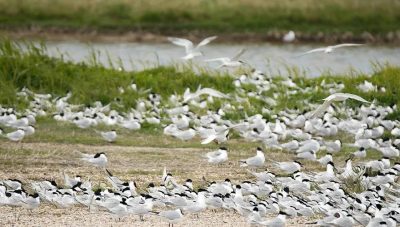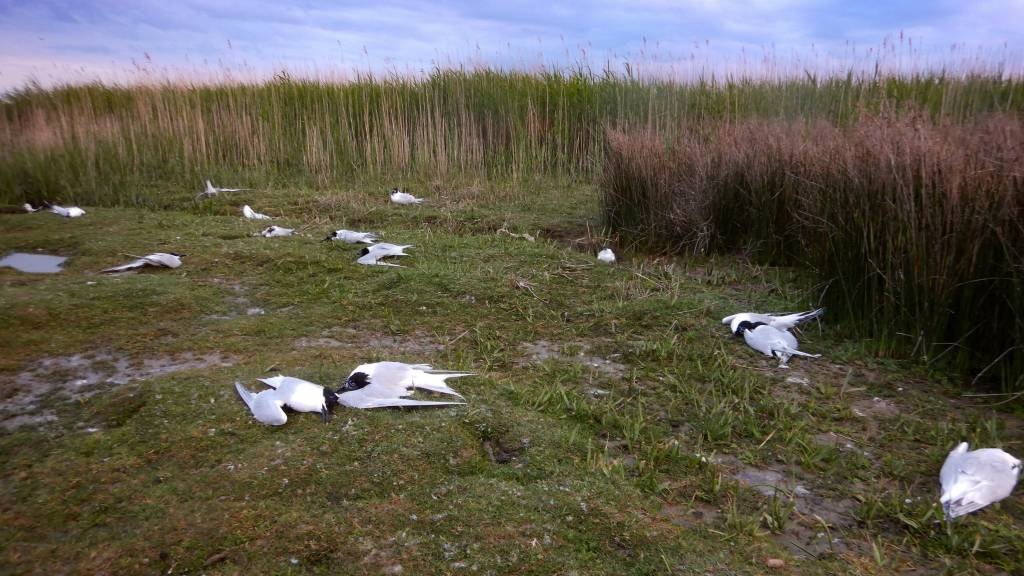Birds are disappearing round the world
Fri 12:46 pm +01:00, 23 Jun 2023Sea Birds’ Last Refuges: 4G and 5G Radiation Sickness from the Cell Towers

All Global Research articles can be read in 51 languages by activating the Translate Website button below the author’s name.
To receive Global Research’s Daily Newsletter (selected articles), click here.
Click the share button above to email/forward this article to your friends and colleagues. Follow us on Instagram and Twitter and subscribe to our Telegram Channel. Feel free to repost and share widely Global Research articles.
***
All over the Earth, birds — symbols of freedom and joy — have been disappearing, and unless we stop killing them, they will never more enliven our skies and imaginations.
They are terns, seagulls, avocets, gannets, skuas, guillemots, puffins, oystercatchers, ducks, geese, godwits, pheasants, magpies, sanderlings, storks, cranes, pelicans, herons, swans, loons, sparrows, pigeons, red-winged blackbirds, owls, cormorants, grebes, dunlins, crows, ravens, bald eagles, hawks, falcons, vultures, all of them vanishing from the landscapes of our homes, forests, sea coasts and minds. It rarely makes the news, and a world grown accustomed to ever-dwindling resources and diminishing life has not been paying attention.
The warning of a Silent Spring, sounded sixty years ago like a trumpet’s blare, has shrunken from a year-round emergency to the almost-meaningless ritual of Earth Day, celebrated just once a year.
But last spring, during May and June, the world was awakened to shocking tales and heart-rending photographs of dead seabirds littering their breeding grounds all over the Northern Hemisphere, nowhere so vividly as in the De Petten Nature Reserve on the island of Texel in the Netherlands, where the corpses of Sandwich terns littered the ground as if they had fallen dead out of the sky in mid-flight:
Texel Island, early June 2022
Ornithologists and bird conservation organizations, reflexively, said to themselves and the world, “This must be bird flu,” and they dressed in hazmat suits and masks as they wandered among the avian graveyards with their specimen collectors and testing equipment, while ignoring obvious signs to the contrary.
Bird flu, they pronounced, is so contagious and deadly that it travels round the world in days, spreads like water between species, and kills entire colonies in weeks. While ignoring the fact that two Dutch colonies of Sandwich terns just 20 miles apart during the same breeding season had completely different outcomes: Waterdunen, whose 7,000 nesting birds were completely wiped out, and Yerseke Moer, whose smaller colony suffered zero mortality. That in France, 3,000 Sandwich terns at Platier d’Oye were entirely killed while thousands of pairs of Sandwich terns at Polder de Sébastopol had no disease at all. That bird flu was an autumn and winter disease and had never before been known to occur in spring or summer. And that it had never before affected so many different kinds of birds at once.
But this was not “bird flu”, it was radiation sickness from cell towers, as documented in my newsletter of July 28, 2022.
Eighteen new 4G antennas had been added to three cell towers located at De Petten, within the territory where the birds were breeding, just days before they began dying. And a large number of other antennas and towers were aimed at the reserve from across a busy shipping lane whose traffic made heavy use of those antennas. While Yerseke Moer is host to no cell towers, has far fewer antennas aimed at it, and is in an isolated location, not near a major port, and not on a shipping lane.
Similarly, in France, dozens of new 4G and 5G antennas had just been added to towers near and at the reserve at Platier d’Oye, located near the port of Calais, while the Polder de Sébastopol is on an isolated island with no towers, few human residents or visitors and far from any shipping traffic.
One year later
In August 2022, researchers were astonished to find that 600 pairs of Sandwich terns — at least some of whom had come from the colonies that had been wiped out — had decided to try again so late in the season. They laid their eggs and raised at least 300 young birds, successfully, during July and August in a new location on Texel Island, a beach at the Prince Hendrik Sand Dike, owned by the water authority, Hoogheemraadschap Hollands Noorderkwartier (HHNK). And this spring in 2023, the Prince Hendrik Sand Dike is filled with almost 3,000 breeding pairs of Sandwich terns, while a second reserve — the island of De Bliek in the Haringvliet — has more than 2,000 breeding pairs. These two colonies, and five smaller colonies, total about half the number of Sandwich terns of previous years.
They are thriving, but all of last spring’s disastrous breeding grounds, many of which had been the breeding grounds for this species for years or decades, have been abandoned. “It is striking: the areas with colonies that were heavily affected by bird flu last year remained vacant this year, including those of Waterdunen (ZL), Wagejot and De Petten on Texel (NH), Griend and De Putten near Camperduin (NH)”, wrote Ruud van Beusekom of Vogelbescherming Nederland (BirdLife Netherlands) on June 5, 2023.
Now everyone is assuming that the birds nesting successfully this year have acquired immunity from the H5N1 influenza virus. But the areas chosen this year by the Sandwich terns are lower-radiation areas. The Prince Hendrik Sand Dike, the only breeding ground for these birds this year on the island of Texel, is the quietest, least visited beach on the island. The nearest antennas are about 3 kilometers away, and because of the small number of visitors and ships they are little used and emit little radiation. Likewise De Bliek, in the Haringvliet, is an island with no people and no antennas in a closed waterway visited by few ships.
Another anomaly not explained by researchers is the fact that removing all dead birds from the colonies last year increased mortality: “Last year it appeared that collecting carcasses in colonies has a negative effect on the further spread of bird flu,” wrote Odessa Langeveld on May 12 of this year. In other words, leaving virus-infected carcasses to rot on the breeding grounds decreased the spread of the disease, while removing them increased its spread. But no one is considering that the teams of workers removing the carcasses on a daily basis were all carrying and using mobile phones, which not only were emitting radiation themselves but were forcing the cell towers on or near the site to be continuously active.
It bears repeating that influenza, whether in people, animals, or birds, has never been demonstrated to be a contagious disease. In 1918, at the very height of the Spanish influenza, attempts by medical teams in Boston and San Francisco to demonstrate the contagious nature of the flu met with complete and resounding failure. Such experiments in humans were published in the Journal of the American Medical Association, the Boston Medical and Surgical Journal, and Public Health Reports. Such experiments in horses were published in Veterinary Journal.
Chapters 7, 8 and 9 of my book, The Invisible Rainbow: A History of Electricity and Life, are devoted to a complete, detailed examination of the history and science of influenza. Chapter 16, the longest chapter in the book, is devoted in part to the effects of electromagnetic radiation on birds. I suggest that all bird conservation organizations should acquire my book and read it carefully.
I receive reports from observers around the world about birds disappearing from sea coasts after cell towers are built on them. Just yesterday, for example, this email came from Manju Carrow, writing about a new Verizon tower on a quiet cape in Florida:
“I went to Cape San Blas, Florida last week. Sometime between April 2022 and before June 11th, 2023 they added a cell tower to the cape. Granted there are 2 nearby, but not directly on the cape. I have gone there 5 times since 2020. The cape has only homes and some small shops, no hotels. On all the beaches I’ve ever been to, there are many birds on the beach. For the first time on a beach, I didn’t see the little sandpipers and other birds that usually run on the beach when the waves go out to peck at the bugs. I mentioned it to a resident and actually they realized the same thing, they just hadn’t noticed. Of course, on day one when I realized I had only seen 2 birds all day I immediately thought of the new tower.”
*
Note to readers: Please click the share button above. Follow us on Instagram and Twitter and subscribe to our Telegram Channel. Feel free to repost and share widely Global Research articles.
Arthur Firstenberg, President, Cellular Phone Task Force, Author, The Invisible Rainbow: A History of Electricity and Life, Administrator, International Appeal to Stop 5G on Earth and in Space, Caretaker, ECHOEarch.org (End Cellphones Here On Earth)











